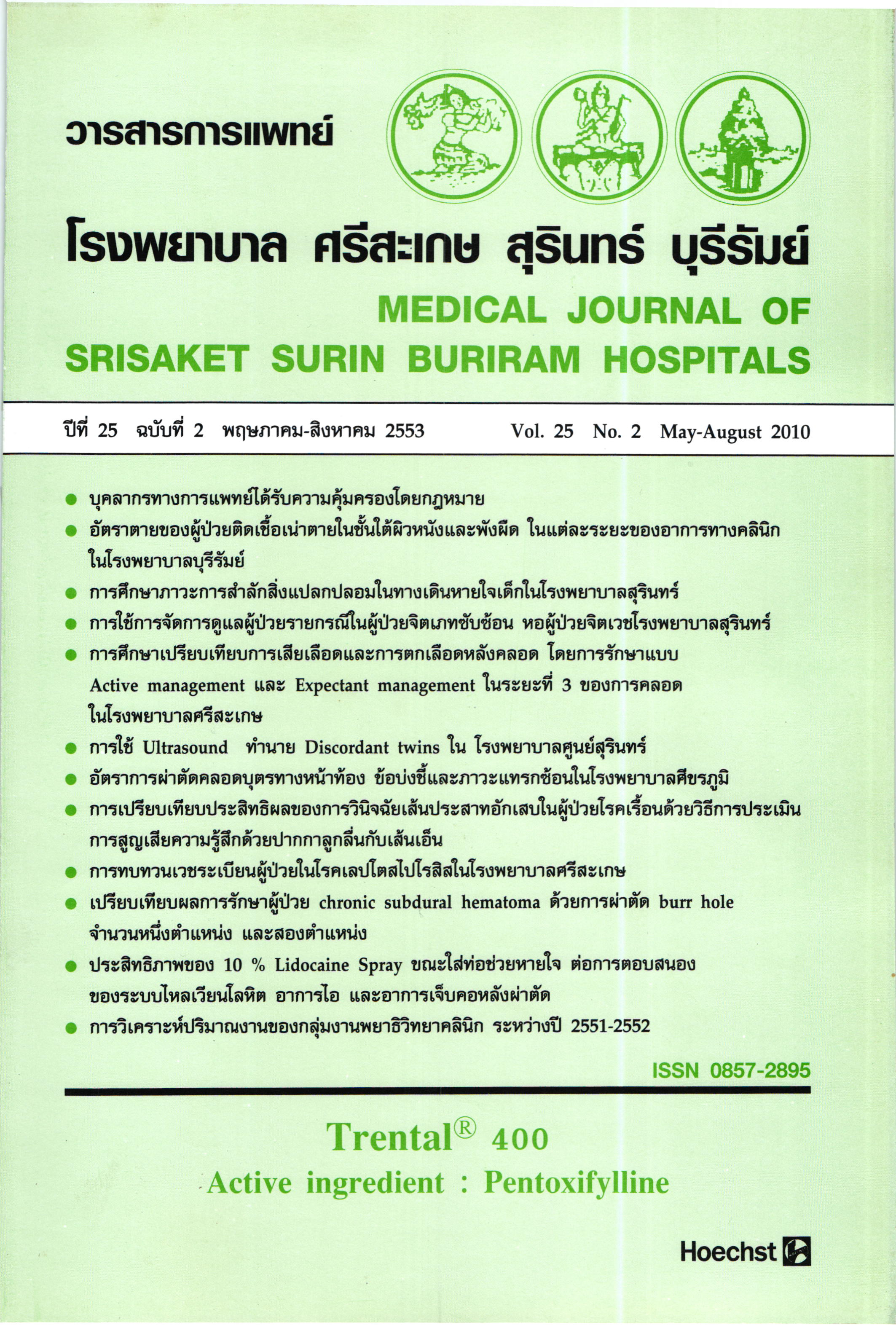การศึกษาเปรียบเทียบการเสียเลือดและการตกเลือดหลังคลอด โดยการรักษาแบบ Active management และ Expectant management ในระยะที่ 3 ของการคลอดในโรงพยาบาลศรีสะเกษ
Main Article Content
บทคัดย่อ
หลักการและเหตุผล: การตกเลือดหลังคลอด หมายถึง การที่มีเลือดออกทางซ่องคลอดตั้งแต่ 500 มิลลิลิตร ขึ้นไป หลังจากสิ้นสุดระยะที่ 3 ของการคลอด และเป็นสาเหตุที่สำคัญที่สุดทำให้มารดาเสียชีวิต สาเหตุของการตกเลือดหลังคลอดส่วนใหญ่เกิดจาก มดลูกหดรัดตัวไม่ดี ปัจจุบันโรงพยาบาลศรีสะเกษได้นำเทคนิคการช่วยการคลอด แบบก้าวหน้าในระยะที่ 3 ของการคลอดมาใช้ พบว่าอัตราการตกเลือดหลังคลอด มีแนวโน้มลดลง
วัตถุประสงค์: เพื่อเปรียบเทียบผลการรักษาแบบ Active management และ Expectant management ในระยะที่ 3 ของการคลอด ในเรื่องปริมาณการเสียเลือดและ การตกเลือดหลังคลอด ระยะเวลาที่ใช้ในการคลอดระยะที่ 3 และอาการแทรกซ้อนหลังคลอดภายใน 24 ชั่วโมง
รูปแบบการวิจัย: การวิจัยครั้งนี้เป็นการวิจัยแบบทดลอง (Experimental research) ชนิด Clinical trial
กลุ่มตัวอย่าง: ผู้มาคลอดปกติในโรงพยาบาลศรีสะเกษ ตั้งแต่ 1 ตุลาคม 2552 ถึง 31 มีนาคม 2553
ผลการศึกษา: ผู้คลอดทั้งหมด 130 คน ใช้การสุ่มเข้ากลุ่ม 2 กลุ่มๆ ละ 65 คน กลุ่มตัวอย่าง ทั้งสองกลุ่มมีลักษณะข้อมูลส่วนบุคคลไม่แตกต่างอย่างมีนัยสำคัญทางสถิติ ในด้านอายุ อายุครรภ์ ความดันโลหิตล่างเฉลี่ย และน้ำหนักเด็ก ยกเว้นด้าน ความดันโลหิตบนเฉลี่ย และน้ำหนักรก มีความแตกต่างกันอย่างมีนัยสำคัญ ทางสถิติ ระยะเวลาในการคลอดระยะที่ 3 เฉลี่ย 5.72, 11.45 นาที ในกลุ่มที่ 1 กลุ่มที่ 2 ตามลำดับ ปริมาณการสูญเสียเลือดเฉลี่ยจากการชั่งน้ำหนัก 317.60, 377.54 มิลลิลิตร ในกลุ่มที่ 1 กลุ่มที่ 2 ตามลำดับ ปริมาณการสูญเสียเลือด เฉลี่ยจากการคาดคะเน 224.00, 232.00 มิลลิลิตร ในกลุ่มที่ 1 กลุ่มที่ 2 ตามลำดับ ความแตกต่างของค่าความเข้มเลือด ( hematocrit ) ก่อนคลอดและหลังคลอด 24 ชั่วโมง เฉลี่ยร้อยละ 1.42, 1.44 ในกลุ่มที่ 1 กลุ่มที่ 2 ตามลำดับ การหลัง ตกเลือดหลังคลอดเฉลี่ยร้อยละ 1.97, 0.21 โนกลุ่มที่ 1 กลุ่มที่ 2 ตามลำดับ
สรุป: ระยะเวลาในการคลอดระยะที่ 3 ปริมาณการสูญเสียเลือดจากการชั่งน้ำหนัก มีความแตกต่างกันอย่างมีนัยสำคัญทางสถิติ ส่วนอัตราการตกเลือดหลังคลอด ไม่มีความแตกต่างกันอย่างมีนัยสำคัญทางสถิติ จึงควรพัฒนาการช่วยคลอดแบบ ก้าวหน้าในระยะที่ 3 ของการคลอดให้มีประสิทธิภาพยิ่งขึ้น โดยทำหัตถการนี้ โดยผู้ทำคลอดที่มีความชำนาญ
คำสำคัญ: Active management, expectant management, third stage of labor, postpartum hemorrhage
Article Details
เอกสารอ้างอิง
Cunninham FG, Gantt NF, Leveno KJ, Gilstrap LCIH, Hauth JC, Wenstrom KD. Williams Obstetrics. 21th ed ; New York : McGraw-Hill ; 2001 : 635-52.
Muthaporn.Sirirat. The Evaluation of Uterotonic Drugs Use in The Second Ended Stage of Labor and after Placenta Delivery at Mahasarakham Hospital. Mahasaralham : Mahasarakham Hospital ; 2005 : 1,9-11, 31, 42-3, 49, 57.
สำนักงานสาธารณสุขจังหวัดศรีสะเกษ งานอนามัยแม่และเด็ก. รายงานงานอนามัย แม่และเด็กประจำปี พ.ศ.2550-2552. ศรีสะเกษ : สำนักงานฯ ; 2552. (เอกสาร อัดสำเนา)
โรงพยาบาลศรีสะเกษ กลุ่มงานสูติ-นรีเวฃกรรม งานห้องคลอด. รายงานผู้คลอด ประจำปี พ.ศ.2550-2552.ศรีสะเกษ : โรงพยาบาลฯ ; 2552. (เอกสารอัดสำเนา)
Maughan Karen L, Heim Steven W, Galazka Sim S. Preventing Postpartum Hemorrhage : Managing the Third Stage of Labor. AAFP 2006 : 73 (6) : 1025-8.
World Health Organization. Active management of the third stage. In : Department of Reproductive Health and Research Family and Community health World Health Organization. Integrated Management of Pregnancy and Childbirth Managing complication in pregnancy and Childbirth :A guide for midwives and doctors. India : World Health Organization; 2003. : c73-5.
Fawcus S. Treatments for primary postpartum haemorrhage. In: The WHO Reproductive Health Library RHL Informing Best Practice in Reproductive Health. No. 8 ed. Oxford : update Software; 2005.
Abalos E. Active versus expectant management in the third stage of labour. In : The WHO Reproductive Health Library RHL Informing Best Practice in Reproductive Health. No. 8 ed. Oxford : Update Software; 2005.
Prendeville WJ, Harding JE, Elboume DR, Stirrat GM. The Brital third stage of trial : Active versus Physiological management of third stage of labour . BMJ 1998 ; 297(6659) : 1295-3.
Sukprasert M, Choktanasiri W, Ayudhya NI, et al. Increase accuracy of visual estimation of blood loss from education programme.J Med Assoc Thai 2006 ; 89(Suppl4):S54-9.
Zamora LA. A randomized controlled trial of oxytocin administered at the end of the second stage of labour versus administered at the end of the third stage of labour in the prevention of postpartum hemorrhage. Philipp J Obstet Gynecol 1999;23(4):125-33.
Fenton JJ, Baumeister LM, Fogarty J. Active management of the third stage of labor among American Indian Women. Fam Med 2005 ; 37(6):410-4.


